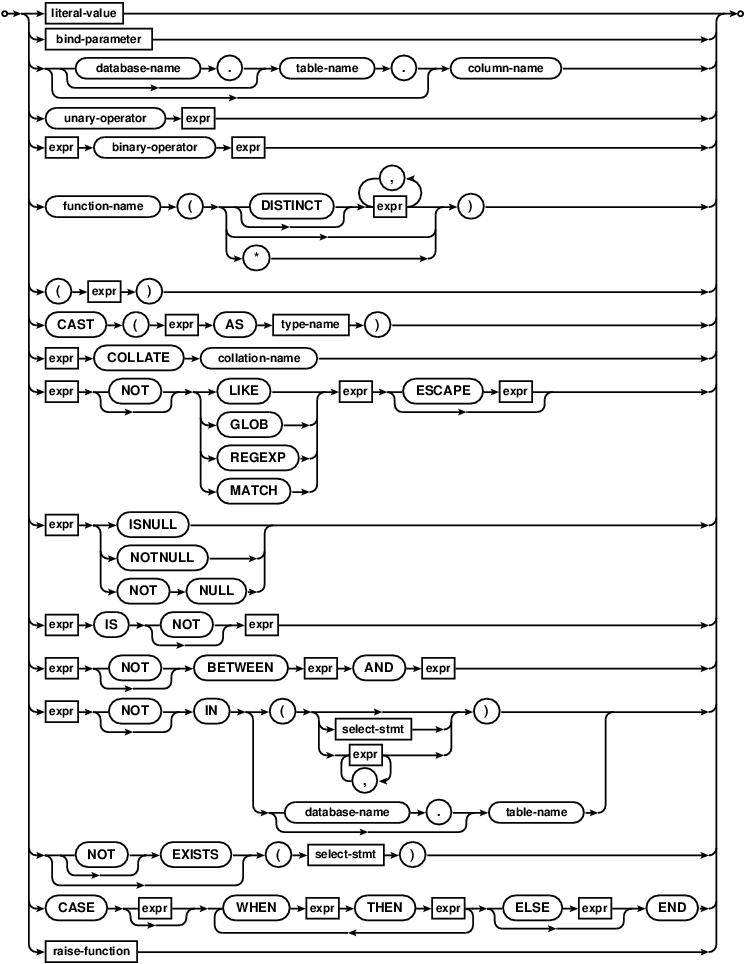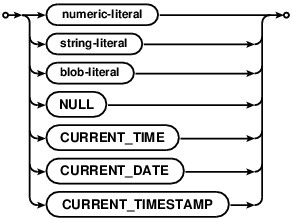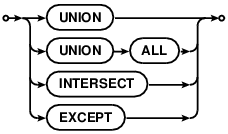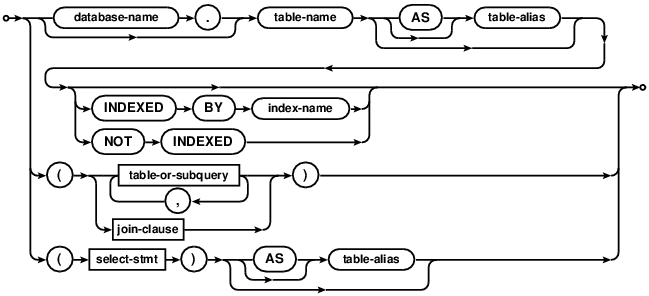
Choose any three.
|
|
SQLite里的SQL
SQL As Understood By SQLite
expression
这一章和其它的章节不太一样,其它大多数章节通常是介绍某个SQL命令。这一章不是介绍某个单独的命令,而是其它大多数命令中的组成部分——"表达式"。
This section is different from the others. Most other sections of
this document talks about a particular SQL command. This section does
not talk about a standalone command but about "expressions" which are
subcomponents of most other commands.
操作符
Operators
SQLite支持下列的二元操作符,按优先级从高到低排序:
SQLite understands the following binary operators, in order from
highest to lowest precedence:
|| * / % + - << >> & | < <= > >= = == != <> IS IS NOT IN LIKE GLOB MATCH REGEXP AND OR
支持的一元前缀操作符如下:
Supported unary prefix operators are these:
- + ~ NOT
COLLATE操作符是一个一元后缀操作符,用来为一个表达式指定一个排序器。COLLATE操作符的优先级(约束更紧)比除"~"以外的所有二元和一元前缀操作符都高。(COLLATE和"~"是相关联的,所以他们的绑定顺序无需关注。)使用COLLATE操作符指定的排序器会覆盖由表的列定义中COLLATE子句决定的排序器。更多内容参见SQLite3数据类型文档中的排序器章节。
The COLLATE operator is a unary postfix
operator that assigns a collating sequence to an expression.
The COLLATE operator has a higher precedence (binds more tightly) than any
binary operator and any unary prefix operator except "~".
(COLLATE and "~" are associative so their binding order does not matter.)
The collating sequence set by the COLLATE operator overrides the
collating sequence determined by the COLLATE clause in a table
column definition.
See the detailed discussion on collating sequences
in the Datatype In SQLite3 document for additional information.
+一元操作符没有直接的操作的。可以在字符串、数字、BLOB、NULL值上使用它,返回值通常与操作值一样。
The unary operator + is a no-op. It can be applied
to strings, numbers, blobs or NULL and it always returns a result
with the same value as the operand.
注意相等和不等操作符有两个变种。= 和 ==都可以判断相等。!= 和 <>都可以判断不等。
||操作符是"连接符"——将操操作值的两个字符串连接到一起。
%输出左边操作值按右边值取模的结果值。
Note that there are two variations of the equals and not equals
operators. Equals can be either
= or ==.
The non-equals operator can be either
!= or <>.
The || operator is "concatenate" - it joins together
the two strings of its operands.
The operator % outputs the value of its left
operand modulo its right operand.
除了||连接符的计算结果为NULL或一个文本外,其他的所有二元操作符的计算结果都是数字值或者NULL。
The result of any binary operator is either a numeric value or
NULL, except for the || concatenation operator which always
evaluates to either NULL or a text value.
IS 和 IS NOT操作符的功能与= 和 !=类似,不过如果其中一个或两个操作数是NULL,那么它们则不相同。在这种情况下,如果两个操作数都是NULL,那么IS操作符返回1(true)并且IS NOT操作符返回0(false)。如果一个操作数是NULL,另一个不是NULL,那么IS操作符返回0(false),IS NOT操作符返回1(true)。IS和IS NOT表达式不会出现计算返回NULL的情况。操作符IS 和 IS NOT的优先级与=一样。
The IS and IS NOT operators work
like = and != except when one or both of the
operands are NULL. In this case, if both operands are NULL, then the
IS operator evaluates to 1 (true) and the IS NOT operator evaluates
to 0 (false). If one operand is NULL and the other is not, then the
IS operator evaluates to 0 (false) and the IS NOT operator is 1 (true).
It is not possible for an IS or IS NOT expression to evaluate to NULL.
Operators IS and IS NOT have the same
precedence as =.
字面值
Literal Values
字面值是一些类型的常量。字面值可以是整数、浮点数、字符串、BLOB或者NULL。
A literal value is a constant of some kind.
Literal values may be integers, floating point numbers, strings,
BLOBs, or NULLs.
整数和浮点数字面值(全部"数字字符值")的语法如下图所示:
The syntax for integer and floating point literals (collectively
"numeric literals") is shown by the following diagram:
如果数字字面量有一个小数点或者一个幂子句,那么这是一个浮点字面量,否则就是一个证书字面量。浮点字面量中幂子句前面的字符"E"大小写都可以。"."字符总是用来作为小数点,即使本地设置中指定使用","来当小数点——使用","作为小数点会导致语句模糊不清。
If a numeric literal has a decimal point or an exponentiation
clause, then it is a floating point literal. Otherwise is it is an
integer literal. The "E" character that begins the exponentiation
clause of a floating point literal can be either upper or lower case.
The "." character is always used
as the decimal point even if the locale setting specifies "," for
this role - the use of "," for the decimal point would result in
syntactic ambiguity.
字符串常量是由包在单引号(')中的字符串构成。字符串里的单引号可以使用两个连续的单引号来转义——类似Pascal。这里不支持C风格中使用反斜杠的转义,因为这不是标准SQL。BLOB字面量是一个包含十六进制值的字符串字面量,并且在前面加一个"x"或"X"。例如:
A string constant is formed by enclosing the
string in single quotes ('). A single quote within the string can
be encoded by putting two single quotes in a row - as in Pascal.
C-style escapes using the backslash character are not supported because
they are not standard SQL.
BLOB literals are string literals containing hexadecimal data and
preceded by a single "x" or "X" character. For example:
X'53514C697465'
字面量还可以是"NULL"。
A literal value can also be the token "NULL".
参数
Parameters
一个"variable" 或 "parameter"标志可以在表达式中指定一个占位符,可以在运行时使用C/C++接口中的sqlite3_bind()类接口来填入具体值。参数可以有如下这些格式:
A "variable" or "parameter" token
specifies a placeholder in the expression for a
value that is filled in at runtime using the
sqlite3_bind() family of C/C++ interfaces.
Parameters can take several forms:
?NNN 一个问号加一个数字NNN表示这个位置的值是第NNN个参数。NNN必须在1到SQLITE_MAX_VARIABLE_NUMBER之间。
A question mark followed by a number NNN holds a spot for the NNN-th parameter. NNN must be between 1 and SQLITE_MAX_VARIABLE_NUMBER.? 一个没有跟随数字的问号表示这个位置是第N+1个参数,其中N是前面已经指定了的最大的参数序号。如果N+1大于SQLITE_MAX_VARIABLE_NUMBER,那么会产生一个错误。
A question mark that is not followed by a number creates a parameter with a number one greater than the largest parameter number already assigned. If this means the parameter number is greater than SQLITE_MAX_VARIABLE_NUMBER, it is an error.:AAAA 冒号加一个标识符表示这个位置的值是一个名为:AAAA的命名参数。命名参数也同样是有编号的,为其分配的编号是比前面已经分配的最大编号参数的编号加1。如果这个编号大于SQLITE_MAX_VARIABLE_NUMBER,那么会产生一个错误。为了避免产生混淆,最好避免同时使用命名参数和编号参数。
A colon followed by an identifier name holds a spot for a named parameter with the name :AAAA. Named parameters are also numbered. The number assigned is one greater than the largest parameter number already assigned. If this means the parameter would be assigned a number greater than SQLITE_MAX_VARIABLE_NUMBER, it is an error. To avoid confusion, it is best to avoid mixing named and numbered parameters.@AAAA @符的作用和冒号类似,只不过参数的名字是@AAAA。
An "at" sign works exactly like a colon, except that the name of the parameter created is @AAAA.$AAAA 美元符加一个标识符表示这个位置的值是一个名为$AAAA的命名参数。在这种情况下,标识符名字里可以包含一个或多个"::"以及包含任何文本的"(...)"后缀。这是Tcl 编程语言中变量名的格式。之所以提供这种语法是因为SQLite实际上是一个Tcl 扩展。
A dollar-sign followed by an identifier name also holds a spot for a named parameter with the name $AAAA. The identifier name in this case can include one or more occurrences of "::" and a suffix enclosed in "(...)" containing any text at all. This syntax is the form of a variable name in the Tcl programming language. The presence of this syntax results from the fact that SQLite is really a Tcl extension that has escaped into the wild.
没有使用sqlite3_bind()指定值的参数会被视为NULL。
Parameters that are not assigned values using
sqlite3_bind() are treated
as NULL.
参数的最大数量是在编译器使用SQLITE_MAX_VARIABLE_NUMBER指令设定的。每个数据库连接可以使用sqlite3_limit(D, SQLITE_LIMIT_VARIABLE_NUMBER,...) 接口将最大参数数调到编译器指定的最大值以下。
The maximum parameter number is set at compile-time by
the SQLITE_MAX_VARIABLE_NUMBER macro. An individual database connections
D can reduce its maximum parameter number below the compile-time maximum
using the sqlite3_limit(D, SQLITE_LIMIT_VARIABLE_NUMBER,...) interface.
LIKE和GLOB运算符。
The LIKE and GLOB operators
LIKE操作符是用来做模式匹配比较的。LIKE操作符右边的操作数是进行匹配的模式,左边是需要进行匹配的字符串。
LIKE模式中的百分号("%")匹配字符串中任意零个或多个字符的序列。LIKE模式中的下划线("_")匹配字符串中的一个字符。其他所有的字符用于匹配字符自身或者对应的大/小写字符(也就是不区分大小写)。(一个bug:SQLite默认只支持ASCII字符的不区分大小写匹配。对于超过ASCII范围的unicode字符LIKE操作符默认是大小写敏感的。例如,表达式'a' LIKE 'A'是TRUE,而'æ' LIKE 'Æ'则是FALSE。)
The LIKE operator does a pattern matching comparison. The operand
to the right of the LIKE operator contains the pattern and the left hand
operand contains the string to match against the pattern.
A percent symbol ("%") in the LIKE pattern matches any
sequence of zero or more characters in the string. An underscore
("_") in the LIKE pattern matches any single character in the
string. Any other character matches itself or its lower/upper case
equivalent (i.e. case-insensitive matching). (A bug: SQLite only
understands upper/lower case for ASCII characters by default. The
LIKE operator is case sensitive by default for unicode characters that are
beyond the ASCII range. For example,
the expression 'a' LIKE 'A'
is TRUE but 'æ' LIKE 'Æ' is FALSE.)
如果使用了可选的ESCAPE子句,那么ESCAPE关键词后面的表达式结果必须是一个只有一个字符的字符串。这个逃逸字符可以使用在LIKE模式中,包括百分号和下划线字符。在逃逸字符后跟百分号(%)、下划线(_)或逃逸字符本身,用于匹配一个百分号、下划线或者单个逃逸字符。
If the optional ESCAPE clause is present, then the expression
following the ESCAPE keyword must evaluate to a string consisting of
a single character. This character may be used in the LIKE pattern
to include literal percent or underscore characters. The escape
character followed by a percent symbol (%), underscore (_), or a second
instance of the escape character itself matches a
literal percent symbol, underscore, or a single escape character,
respectively.
LIKE表达式是通过调用应用定义的SQL函数like(Y,X) 或
like(Y,X,Z)来实现的。
The infix LIKE operator is implemented by calling the
application-defined SQL functions like(Y,X) or
like(Y,X,Z).
LIKE操作符可以使用case_sensitive_like 指令来改为大小写敏感。
The LIKE operator can be made case sensitive using the
case_sensitive_like pragma.
GLOB操作符类似LIKE,但是通配符使用的是Unix文件通配符语法。并且,GLOB是大小写敏感的,而不像LIKE。GLOB和LIKE都可以通过前缀NOT关键词来反转表意。GLOB操作符通过调用glob(Y,X)函数实现的,并且可以通过重写该函数来修改。
The GLOB operator is similar to LIKE but uses the Unix
file globbing syntax for its wildcards. Also, GLOB is case
sensitive, unlike LIKE. Both GLOB and LIKE may be preceded by
the NOT keyword to invert the sense of the test. The infix GLOB
operator is implemented by calling the function
glob(Y,X) and can be modified by overriding
that function.
REGEXP操作符是regexp()用户函数的语法。默认情况下没有定义regexp()函数,所以使用REGEXP操作符通常会返回一个错误信息。如果运行时加入了一个名为"regexp"的应用定义SQL函数,那么"X REGEXP Y"操作会通过调用"regexp(Y,X)"实现。
The REGEXP operator is a special syntax for the regexp()
user function. No regexp() user function is defined by default
and so use of the REGEXP operator will normally result in an
error message. If an application-defined SQL function named "regexp"
is added at run-time, then the "X REGEXP Y" operator will
be implemented as a call to "regexp(Y,X)".
MATCH操作符是用来调用应用定义函数match()的语法。默认的match()函数实现是抛出一个异常,一般来说这是没有意义的。但是扩展可以覆盖这个函数来增加有用的逻辑。
The MATCH operator is a special syntax for the match()
application-defined function. The default match() function implementation
raises an exception and is not really useful for anything.
But extensions can override the match() function with more
helpful logic.
BETWEEN操作符
The BETWEEN operator
BETWEEN操作符在逻辑上等价于一对比较。"x BETWEEN y AND z" 等价于"x>=y AND x<=z",只不过在BETWEEN中,x表达式只会计算一次。BETWEEN操作符的优先级与==、 != 和 LIKE操作符一样,并且是从左向右结合。
The BETWEEN operator is logically equivalent to a pair of comparisons.
"x BETWEEN y AND z" is
equivalent to
"x>=y AND x<=z" except
that with BETWEEN, the x expression is only evaluated once.
The precedence of the BETWEEN operator is the same as the precedence
as operators == and != and LIKE and groups left to right.
CASE表达式
The CASE expression
CASE表达式的角色类似于其他编程语言中的IF-THEN-ELSE。 A CASE expression serves a role similar to IF-THEN-ELSE in other programming languages.
在CASE关键词和第一个WHEN关键词之间的可选表达式叫做"base"表达式。CASE表达式有两个基本形式:使用base表达式和不使用base表达式。
The optional expression that occurs in between the CASE keyword and the
first WHEN keyword is called the "base" expression. There are two basic forms
of the CASE expression: those with a base expression and those without.
在不包含base表达式的CASE中,会从最左边依次向右,将每个WHEN表达式计算,并把结果视为布尔值。CASE表达式的结果是计算第一个返回true的WHEN表达式对应的THEN表达式的计算结果。否则,如果没有WHEN表达式返回true,那么则返回ELSE表达式的计算结果。如果没有ELSE表达式,并且没有WHEN表达式返回true,那么最终结果为NULL。
In a CASE without a base expression, each WHEN expression is evaluated
and the result treated as a boolean, starting with the leftmost and continuing
to the right. The result of the CASE expression is the evaluation of the THEN
expression that corresponds to the first WHEN expression that evaluates to
true. Or, if none of the WHEN expressions evaluate to true, the result of
evaluating the ELSE expression, if any. If there is no ELSE expression and
none of the WHEN expressions are true, then the overall result is NULL.
在计算WHEN语句时返回NULL被认为是false。
A NULL result is considered untrue when evaluating WHEN terms.
在使用base表达式的CASE中。base表达式只会计算一次并且会从左到右依次和每个WHEN表达式的结果进行比较。CASE表达式的结果是第一个比较返回true的WHEN对应的THEN表达式的计算结果。如果没有WHEN表达式与base表达的比较结果为true,那么会返回ELSE表达式的计算结果。如果没有ELSE表达式并且没有WHEN表达式与base表达式相等,那么最终结果为NULL。
In a CASE with a base expression, the base expression is evaluated just
once and the result is compared against the evaluation of each WHEN
expression from left to right. The result of the CASE expression is the
evaluation of the THEN expression that corresponds to the first WHEN
expression for which the comparison is true. Or, if none of the WHEN
expressions evaluate to a value equal to the base expression, the result
of evaluating the ELSE expression, if any. If there is no ELSE expression and
none of the WHEN expressions produce a result equal to the base expression,
the overall result is NULL.
当比较base表达式和WHEN表达式时,排序器、亲和力以及NULL处理规则都和在base表达式与WHEN表达式之间使用=操作符是一样的。
When comparing a base expression against a WHEN expression, the same
collating sequence, affinity, and NULL-handling rules apply as if the
base expression and WHEN expression are respectively the left- and
right-hand operands of an = operator.
两种形式的CASE表达式都是使用懒式/短路的计算方式。
Both forms of the CASE expression use lazy, or short-circuit,
evaluation.
下面两种CASE表达式唯一的不同是x表达式在第一个例子中只计算一次,而在第二个例子中会计算多次。
The only difference between the following two CASE expressions is that
the x expression is evaluated exactly once in the first example but
might be evaluated multiple times in the second:
IN和NOT IN操作符
The IN and NOT IN operators
IN和NOT IN操作符左边是一个标量操作值,右边是一个由包含在圆括号中的零或多个指定的标量组成的集合或者是一个子查询。当IN和NOT IN的右操作值是一个子查询时,这个子查询必须只能有一列结果。当右边操作值是一个空集合时,不管左边操作值是什么值甚至是NULL,IN的返回值都为false,NOT IN的返回值都为true。IN和NOT IN操作符的结果是按照下面表格来决定的:
The IN and NOT IN operators take a single scalar operand on the
left and a vector operand on the right
formed by an explicit list of zero or more scalars or by a
single subquery.
When the right operand of an IN or NOT IN operator is a subquery, the
subquery must have a single result column.
When the right operand is an empty set, the result of IN is false and the
result of NOT IN is true, regardless of the left operand and even if the
left operand is NULL.
The result of an IN or NOT IN operator is determined by the following
matrix:
| 左值是NULL
Left operand is NULL | 右值包含NULL
Right operand contains NULL | 右值是空集合
Right operand is an empty set | 右值中包含左值
Left operand found within right operand | IN操作符的结果
Result of IN operator | NOT IN操作符的结果
Result of NOT IN operator |
|---|---|---|---|---|---|
| no | no | no | no | false | true |
| does not matter | no | yes | no | false | true |
| no | does not matter | no | yes | true | false |
| no | yes | no | no | NULL | NULL |
| yes | does not matter | no | does not matter | NULL | NULL |
注意,IN和NOT IN操作符允许右手边的标量列表为空,但是其它大多数SQL数据库引擎和SQL92标准都要求列表必须至少包含一个元素。
Note that SQLite allows the parenthesized list of scalar values on
the right-hand side of an IN or NOT IN operator to be an empty list but
most other SQL database database engines and the SQL92 standard require
the list to contain at least one element.
EXISTS操作符
The EXISTS operator
EXISTS操作符的返回结果总是0或1.如果EXISTS操作符的右边操作值是一个SELECT语句,那么当这个SELECT语句返回一行或多行记录时,EXISTS操作符返回1,如果这个SELECT返回零行记录,那么EXISTS操作符返回0。
The EXISTS operator always evaluates to one of the integer values 0
and 1. If executing the SELECT statement specified as the right-hand
operand of the EXISTS operator would return one or more rows, then the
EXISTS operator evaluates to 1. If executing the SELECT would return
no rows at all, then the EXISTS operator evaluates to 0.
SELECT语句返回的列数和其中的值都不影响EXISTS操作符的结果。尤其是当行里是否包含NULL值对处理都没有任何的影响。
The number of columns in each row returned by the SELECT statement
(if any) and the specific values returned have no effect on the results
of the EXISTS operator. In particular, rows containing NULL values are
not handled any differently from rows without NULL values.
标量子查询
Scalar Subqueries
一个包括在小括号中的SELECT语句可以被看作为一个标量数值。标量数值中使用的SELECT语句的返回结果必须只能有一列。这个表达式的结果是SELECT语句返回的仅有的那一列数据中第一行数据的值。如果SELECT语句返回数据多于一行,那么第一行之后的所有数据都会被忽略。如果SELECT语句没有返回数据,那么表达式的结果是NULL。也就是标量子查询的LIMIT总为1。给这个SQL语句指定任何其他的LIMIT值都会被忽略。
A SELECT statement enclosed in parentheses may appear as a scalar
quantity. A SELECT used as a scalar quantity must return a result set
with a single column. The result of the expression is the value of the
only column in the first row returned by the SELECT statement. If the SELECT
yields more than one result row, all rows after the first are ignored. If
the SELECT yields no rows, then the value of the expression is NULL.
The LIMIT of a scalar subquery is always 1.
Any other LIMIT value given in the SQL text is ignored.
所有类型的SELECT语句,包括聚合查询和复合 SELECT查询(使用UNION或EXCEPT关键词查询)都可以使用在标量子查询中。
All types of SELECT statement, including aggregate and compound SELECT
queries (queries with keywords like UNION or EXCEPT) are allowed as scalar
subqueries.
表的列名
Table Column Names
列名可以是CREATE TABLE语句中定义的任何名字,也可以是"ROWID"、"OID"、 "_ROWID_"这三个特殊标识符之一。这些特殊标识符都是指代每个关联表中每一行的唯一整数键(rowid)的。这些特殊标识符只有当 CREATE TABLE语句中没有定义同名列的情况下才能引用到行键。在任何可以使用普通列的地方都可以使用rowid。
A column name can be any of the names defined in the CREATE TABLE
statement or one of the following special identifiers: "ROWID",
"OID", or "_ROWID_".
These special identifiers all describe the
unique integer key (the rowid) associated with every
row of every table.
The special identifiers only refer to the row key if the CREATE TABLE
statement does not define a real column with the same name.
The rowid can be used anywhere a regular
column can be used.
在标量子查询或者IN、NOT IN、EXISTS表达式的右值中使用的SELECT语句都可以包含外层查询的列引用。这种子查询被认为是一个关联查询。这个关联查询会在每次需要其结果的时候都重新计算一遍。一个非关联查询只会计算一次并且复用结果。
A SELECT statement used as either a scalar subquery or as the
right-hand operand of an IN, NOT IN or EXISTS expression may contain
references to columns in the outer query. Such a subquery is known as
a correlated subquery. A correlated subquery is reevaluated each time
its result is required. An uncorrelated subquery is evaluated only once
and the result reused as necessary.
CAST表达式
CAST expressions
"CAST(<expr> AS <type-name>)"格式的CAST表达式是用来将<expr>的值转换为<type-name>所指定的不同的存储类。
CAST转换类似于在一个值上发生列亲和性转换,不过不同的是CAST操作符转换会导致有损耗的不可逆的转换,而列亲和力只会做无损耗可逆的转换。
A CAST expression of the form "CAST(<expr> AS <type-name>)"
is used to convert the value of <expr> to
a different storage class specified by <type-name>.
A CAST conversion is similar to the conversion that takes place when a column affinity is applied to a value except that with
the CAST operator the conversion always takes place even if the conversion
lossy and irreversible, whereas column affinity only changes the data type
of a value if the change is lossless and reversible.
如果<expr>的值为NULL,那么CAST表达式的结果也是NULL。否则,结果的存储类是通过执行<type-name>上的列亲和性选择规则来决定的。
If the value of <expr> is NULL, then the result of the CAST
expression is also NULL. Otherwise, the storage class of the result
is determined by applying the rules for determining column affinity to
the <type-name>.
| <type-name>的亲和力
Affinity of <type-name> | 转换处理
Conversion Processing |
|---|---|
| NONE | 将一个值转换到无亲和性的 <type-name>会导致这个值被转换为BLOB。转换到BLOB的过程是首先将这个值按照数据库连接编码 的转换为TEXT,然后再将这个TEXT表示为BLOB字节序列。
Casting a value to a <type-name> with no affinity causes the value to be converted into a BLOB. Casting to a BLOB consists of first casting the value to TEXT in the encoding of the database connection, then interpreting the resulting byte sequence as a BLOB instead of as TEXT. |
| TEXT | 把一个BLOB值转换为TEXT的过程是将构成BLOB的字节序列按照数据库的编码表示成一个文本。
To cast a BLOB value to TEXT, the sequence of bytes that make up the BLOB is interpreted as text encoded using the database encoding. 把INTEGER或REAL值转换为TEXT类似通过sqlite3_snprintf()来输出这个值。只不过结果TEXT的编码使用的是数据库连接的编码。
|
| REAL | 当把一个BLOB值转换为REAL时,这个值会首先转换为TEXT。
When casting a BLOB value to a REAL, the value is first converted to TEXT. 当把一个TEXT值转换为REAL时,首先将文本值中实数所能支持的最长的前缀提取出来,然后把剩余的部分忽略掉。当把一个TEXT转换为REAL时,TEXT值前面的空格部分都会被忽略掉。如果文本前缀无法表示为一个实数,那么结果会转换为0.0。
|
| INTEGER | 当把一个BLOB值转换为INTEGER时,这个值会首先转换为TEXT。
When casting a BLOB value to INTEGER, the value is first converted to TEXT. 当把一个TEXT值转换为INTEGER时,首先将文本值中整数所能支持的最长的前缀提取出来,然后把剩余的部分忽略掉。当把一个TEXT转换为INTEGER时,TEXT值前面的空格部分都会被忽略掉。如果文本前缀无法表示为一个整数,那么结果会转换为0。
将REAL值转换为INTEGER时,结果值为在REAL值和零之间最接近REAL值的整数值。如果REAL值大于有符号整数的最大值(+9223372036854775807),那么,结果将是最大的有符号整数。如果REAL值小于有符号整数的最小值(-9223372036854775808) ,那么结果将是最小的有符号整数。
在SQLite3.8.2版之前,将大于+9223372036854775807.0的REAL转换为整数时结果为最大的负整数-9223372036854775808。这个行为是为了模拟x86/x64硬件做类似的转换时的行为。
|
| NUMERIC | 将TEXT或BLOB值转换为NUMBERIC时,首先强制转换为REAL,然后如果可以无损可逆的转换为INTEGER则再一次将REAL转换为INTEGER。这是SQLite中唯一NUMBERIC和INTEGER亲和力行为不同的环境。
Casting a TEXT or BLOB value into NUMERIC first does a forced conversion into REAL but then further converts the result into INTEGER if and only if the conversion from REAL to INTEGER is lossless and reversible. This is the only context in SQLite where the NUMERIC and INTEGER affinities behave differently. 将REAL或INTEGER转换为NUMBERIC是不会进行操作的,即使实数值可以无损的转换为一个整数也不会进行转换操作。
|
注意,从一个非BLOB值转换为一个BLOB的结果和从一个BLOB值转换为一个非BLOB的结果可能会是不同的,这依赖于数据库的编码是UTF-8、UTF-16be 还是 UTF-16le。
Note that the result from casting any non-BLOB value into a
BLOB and the result from casting any BLOB value into a non-BLOB value
may be different depending on whether the database encoding is UTF-8,
UTF-16be, or UTF-16le.
布尔表达式
Boolean Expressions
SQL语句特定了一些环境,在这些环境下表达式的结果会被转换为布尔值(true或false)。这些环境包括:
The SQL language features several contexts where an expression is
evaluated and the result converted to a boolean (true or false) value. These
contexts are:
- SELECT、UPDATE和DELETE语句中的WHERE子句。
the WHERE clause of a SELECT, UPDATE or DELETE statement, - SELECT语句中连接用的ON和USING子句。
the ON or USING clause of a join in a SELECT statement, - SELECT语句中的HAVING子句。
the HAVING clause of a SELECT statement, - SQL触发器中的WHEN子句。
the WHEN clause of an SQL trigger, and - CASE表达式中的WHEN子句。
the WHEN clause or clauses of some CASE expressions.
在将SQL表达式的结果转换为一个布尔值时,SQLite首先将结果通过与CAST 表达式一样的方法转换成一个NUMBERIC值。NULL或零值(整数值0或者实数值0.0)都会被看做false。其它所有值被看做true。
To convert the results of an SQL expression to a boolean value, SQLite
first casts the result to a NUMERIC value in the same way as a
CAST expression. A NULL or zero value (integer value 0 or real value 0.0) is
considered to be false. All other values are considered true.
例如:NULL、0.0、0、'english' 和 '0'都被视为false。1、1.0、0.1、-0.1和'1english'都被视为true。
For example, the values NULL, 0.0, 0, 'english' and '0' are all considered
to be false. Values 1, 1.0, 0.1, -0.1 and '1english' are considered to
be true.
函数
Functions
普通函数 和 聚合函数都可以支持。(为了展示需要,普通函数又被进一步细分为了核心函数 和 日期时间函数。)
普通函数可以再任何表达式中使用。普通函数会依照输入立即返回结果。而聚合函数只能使用在SELECT语句中。聚合函数会计算结果集中的所有记录行。
Both simple and aggregate functions are supported.
(For presentation purposes, simple functions are further subdivided into
core functions and date-time functions.)
A simple function can be used in any expression. Simple functions return
a result immediately based on their inputs. Aggregate functions
may only be used in a SELECT statement. Aggregate functions compute
their result across all rows of the result set.














